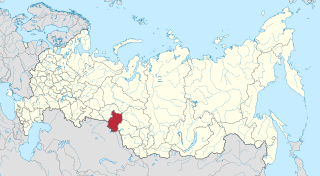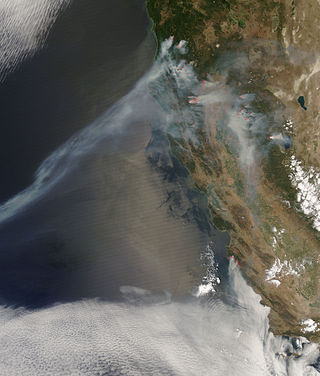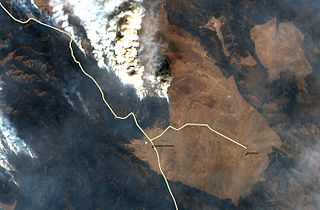
Omsk Oblast is a federal subject of Russia, located in southwestern Siberia. The oblast has an area of 139,700 square kilometers (53,900 sq mi). Its population is 1,977,665 with the majority, 1.12 million, living in Omsk, the administrative center.

Krasnoyarsk Krai is a federal subject of Russia located in Siberia. Its administrative center is the city of Krasnoyarsk, the third-largest city in Siberia, after Novosibirsk and Omsk. Comprising half of the Siberian Federal District, Krasnoyarsk Krai is the largest krai in Russia, the second-largest federal subject in the country after neighboring Sakha, and the third-largest country subdivision by area in the world. The krai covers an area of 2,366,797 square kilometers (913,825 sq mi), constituting roughly 13% of Russia's total area. Krasnoyarsk Krai has a population of 2,856,971 as of the 2021 Census.

Sergei Kuzhugetovich Shoigu is a Russian politician and military officer who has served as Minister of Defence of Russia since 2012. Shoigu has served as the chairman of the Council of Ministers of Defense of the Commonwealth of Independent States since 2012.

The 2008 California wildfire season was one of the most devastating in the state of the 21st century. While 6,255 fires occurred, about two-thirds as many as in 2007, the total area burned— 1,593,690 acres —far exceeded that of previous years.

The 2010 Russian wildfires were several hundred wildfires that broke out across Russia, primarily in the west in summer 2010. They started burning in late July and lasted until early September 2010. The fires were associated with record-high temperatures, which were attributed to climate change—the summer had been the hottest recorded in Russian history—and drought.

From 12 to 16 April 2015, a series of wildfires spread across southern Siberia, Russia. In the Republic of Khakassia, 29 people were killed and 6,000 left homeless. Further east in Zabaykalsky Krai, four people died in wildfires near Chita. Damage was also reported in Inner Mongolia.

On the morning of 1 July 2016, an Ilyushin Il-76 aircraft configured for aerial firefighting and belonging to the Russian Ministry of Emergency Situations crashed near Lake Baikal northeast of Irkutsk in Siberia, Russia. All ten crew members were killed.
Dry, warm conditions in the spring set the stage for fires in Siberia in May 2018.

The 2019 Siberian wildfires began in July 2019 in poorly accessible areas of northern Krasnoyarsk Krai, Sakha Republic and Zabaykalsky Krai, all in Siberia, Russia. By the end of the month the size of the fires reached 2,600,000 hectares. As of 30 July, there had been no reported deaths or injuries due to the fires.

The Norilsk diesel oil spill was an industrial disaster near Norilsk, Krasnoyarsk Krai, Russia. It began on 29 May 2020 when a fuel storage tank at Norilsk-Taimyr Energy's Thermal Power Plant No. 3 failed, flooding local rivers with up to 17,500 tonnes of diesel oil. President Vladimir Putin declared a state of emergency in early June. The incident has been described as the second-largest oil spill in modern Russian history, after the 1994 Komi pipeline spill, where 400,000 tonnes of crude oil were released to the environment between August 1994 and January 1995.
This is an environmental history of the 2020s. Environmental history refers to events and trends related to the natural environment and human interactions with it. Examples of human-induced events include biodiversity loss, climate change and holocene extinction.

From June 2021, the taiga forests in Siberia and the Far East region of Russia were hit by unprecedented wildfires, following record-breaking heat and drought. For the first time in recorded history, wildfire smoke reached the North Pole.

The Listvyazhnaya mine disaster was a mining accident that occurred on 25 November 2021 in a coal mine in Kemerovo Oblast, Russia. Smoke from a fire in a ventilation shaft caused the suffocation of over 40 miners. A failed attempt to rescue the trapped miners resulted in the deaths of at least five rescuers when the mine exploded. It is the deadliest mine accident in Russia since the 2010 Raspadskaya mine explosion in the same region.

There have been attacks in mainland Russia as a result of the Russian invasion of Ukraine, which began on 24 February 2022. The main targets have been the military, the arms industry and the oil industry. Many of the attacks have been drone strikes, firebombing, and rail sabotage. The Ukrainian intelligence services have acknowledged carrying out some of these attacks. Others have been carried out by anti-war activists in Russia. There has also been cross-border shelling, missile strikes and ground raids from Ukraine, mainly in the Belgorod, Kursk and Bryansk oblasts. Several times, Russian anti-Kremlin paramilitaries have launched incursions from Ukraine into Russia, captured border villages and battled the Russian military. While Ukraine has supported these ground incursions, it has denied direct involvement.

The Russian mystery fires are a series of unusual fires and explosions that have occurred since the invasion of Ukraine, which have not been formally explained. There have been many notable arson attacks on military recruitment offices in Russia since the beginning of the war, and there has been speculation that some of the fires or explosions have been the result of sabotage efforts by Russian partisans or Ukrainian saboteurs.

Pro-democratic and pro-Ukrainian partisan movements have emerged in Belarus and Russia following the Russian invasion of Ukraine, a major escalation of the Russo-Ukrainian War. These resistance movements act against the authoritarian governments of Alexander Lukashenko in Belarus and Vladimir Putin in Russia, as well as against civilian supporters of these authorities and the armed forces of both countries, with the aim of stopping the war.
The rail war began in different regions of Russia in the spring of 2022 after a similar rail war in Belarus.
On 5 January 2023, Patriarch Kirill of Moscow, head of the Russian Orthodox Church, called on both sides of the war in Ukraine for an Eastern Orthodox Christmas truce. On the evening of the same day, Russian President Vladimir Putin instructed Russian Defense Minister Sergei Shoigu to declare a 36-hour temporary ceasefire along the entire line of contact between Russian and Ukrainian troops from midday on 6 January to midnight on 7 to 8 January 2023.














